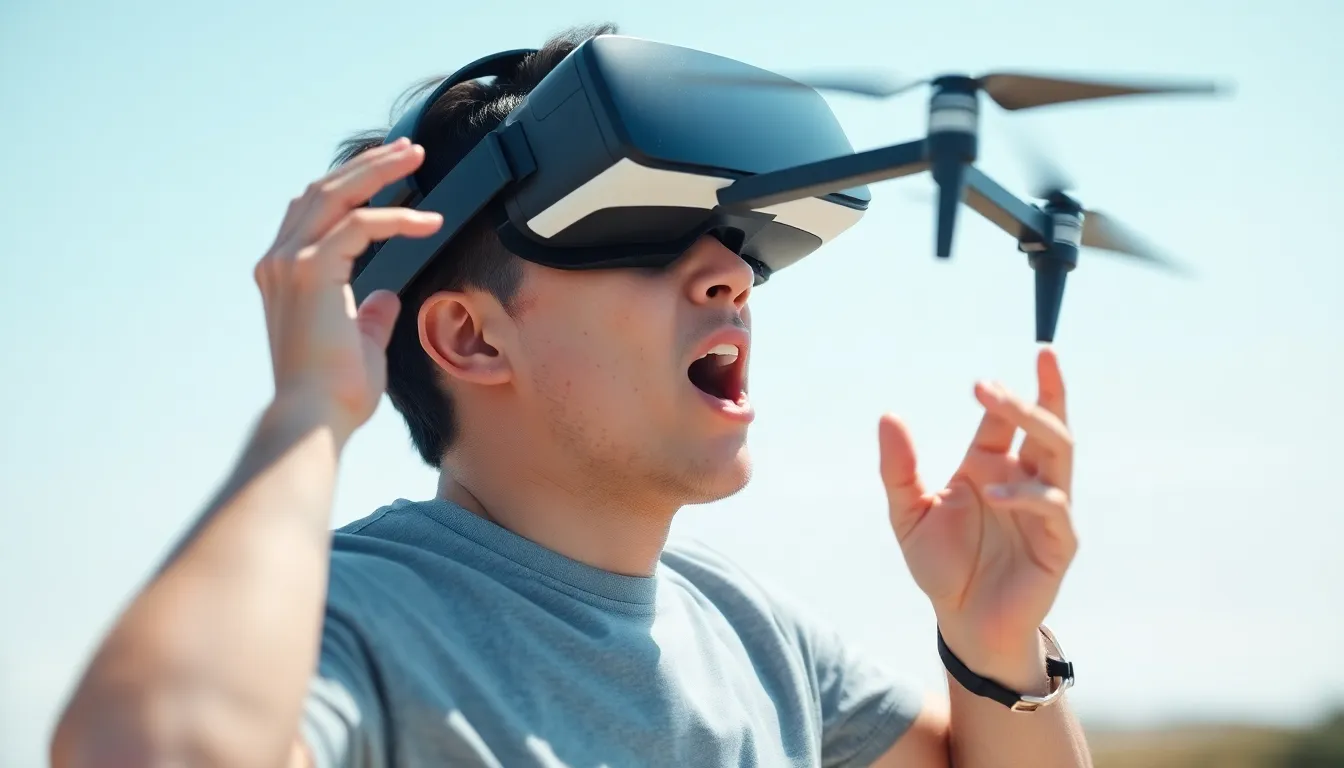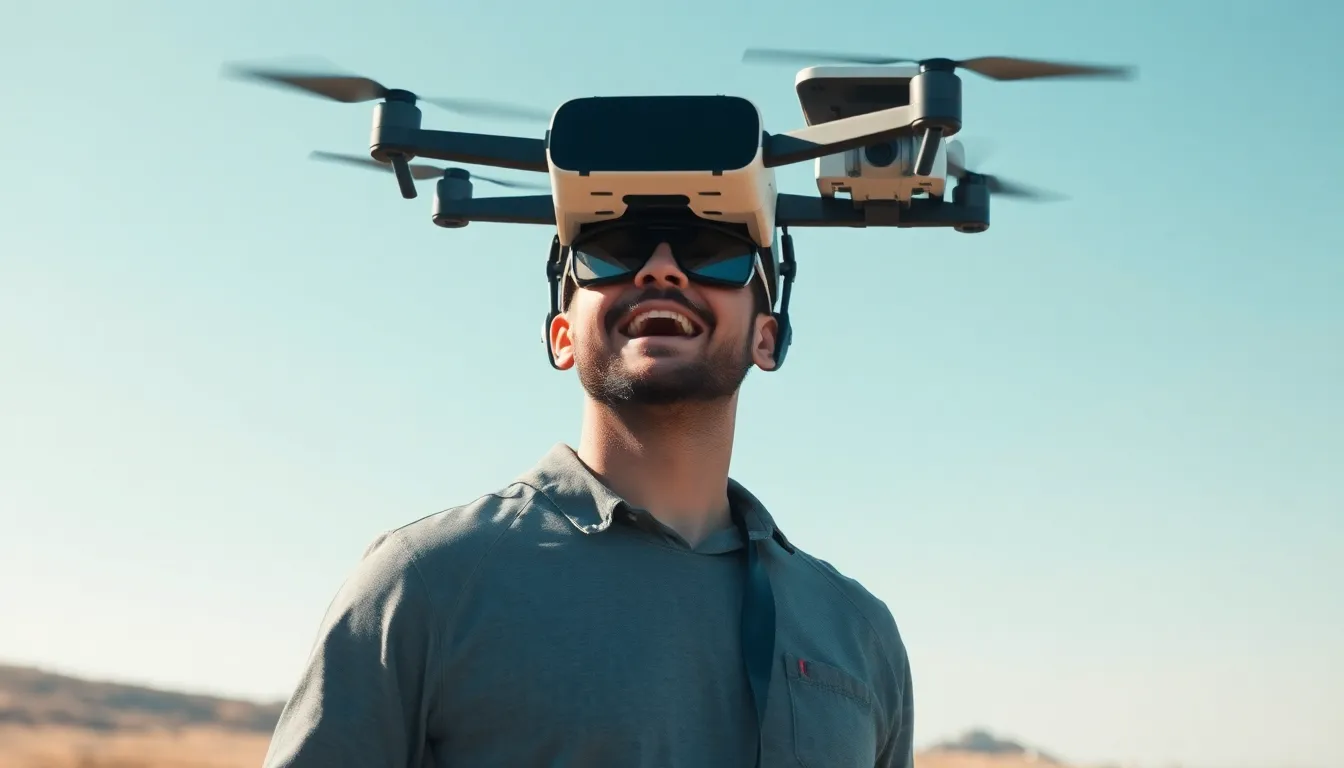As technology continues to evolve, the fusion of drones and virtual reality (VR) headsets is revolutionizing the way enthusiasts experience aerial photography and racing. Drone VR headsets offer an immersive perspective that allows users to see the world from above, transforming ordinary drone flights into exhilarating adventures.
With the ability to navigate through stunning landscapes in real-time, these devices are not just for hobbyists but also for professionals seeking innovative ways to capture content. The combination of high-definition visuals and responsive controls enhances the flying experience, making it more engaging and intuitive. As the popularity of drone VR headsets grows, so does the potential for new applications across various industries.
Table of Contents
ToggleOverview of Drone VR Headsets
Drone VR headsets combine advanced visual technology with drone flight capabilities, offering users a unique perspective and immersive experience. Designed for both recreational and professional use, these headsets strengthen the connection between pilot and aircraft, enabling real-time interaction with aerial environments.
Key features of drone VR headsets include:
- High-definition displays: Most headsets feature resolutions of at least 1080p, delivering sharp images that enhance visual clarity during flight.
- Low latency: Many models offer minimal lag time, ensuring quick response to pilot commands and providing a seamless flight experience.
- Wide field of view: A broader field of view allows for increased awareness of surroundings, which is crucial for both racing and aerial photography.
- Compatibility: Several headsets support a range of drone models, making them versatile options for various users.
Professional creators leverage drone VR headsets for applications in cinematography, surveying, and rescue operations. The enhanced perspective and control enable innovative storytelling and detailed mapping, leading to diverse new opportunities in these fields. In recent years, the growing interest in drone VR technology has resulted in more affordable and user-friendly options, broadening accessibility for hobbyists and professionals alike.
Key Features to Consider

When selecting a drone VR headset, several key features significantly enhance the flying experience. Understanding these characteristics ensures optimal performance and enjoyment from the device.
Display Quality
Display quality plays a vital role in the overall immersive experience. High-definition displays, ideally 1080p or higher, provide crisp images and vibrant colors. Many headsets also incorporate anti-glare technology, reducing reflections and improving visibility in various lighting conditions. Enhanced refresh rates prevent motion blur, enabling smoother visuals during fast maneuvers.
Field of View
Field of view (FOV) significantly impacts user immersion. A wider FOV, typically around 90 to 120 degrees, offers a more panoramic perspective, allowing users to feel as if they’re truly flying. This wider vision enhances situational awareness, crucial for both recreational flying and professional applications like surveying.
Battery Life
Battery life directly affects the duration of flights. Most high-quality drone VR headsets feature batteries that last 2 to 4 hours on a single charge. It’s important to consider the charging time as well; quick-charge options provide a convenient solution for extended use. Users should also look into compatibility with external battery packs for prolonged sessions.
Top Drone VR Headsets on the Market
Multiple drone VR headsets stand out in today’s technology landscape, offering unique features and specifications. Here’s a look at three popular options widely praised for their capabilities.
Product 1: Features and Specifications
DJI Goggles RE
- Display: Dual 1080p screens for high-definition visuals.
- Field of View: 110 degrees, enhancing immersive experiences.
- Latency: Low latency technology ensures real-time flight control.
- Battery Life: Up to six hours on a full charge, supporting extended flight sessions.
- Compatibility: Works seamlessly with DJI drones, like the Mavic Pro and Phantom 4 Pro.
Product 2: Features and Specifications
Fat Shark Dominator HDO2
- Display: 1280×960 resolution for sharp images in various lighting conditions.
- Field of View: Adjustable FOV between 30 to 50 degrees, providing flexibility based on user preference.
- Latency: Low latency for quick responsiveness in fast-paced scenarios.
- Battery Life: Approximately two hours, with optional external batteries for extended use.
- Compatibility: Compatible with a broad range of FPV drones, enhancing operator versatility.
Product 3: Features and Specifications
- Display: Dual AMOLED displays with a 2880×1600 resolution, offering vivid colors.
- Field of View: 110 degrees for an expansive viewing experience.
- Latency: Features inside-out tracking, significantly reducing lag during flights.
- Battery Life: Lasts about three hours on a single charge with the integration of quick-charge capabilities.
- Compatibility: Compatible with various drone models through advanced software integration.
Benefits of Using Drone VR Headsets
Drone VR headsets offer numerous advantages that significantly enhance the user experience.
Immersive Experience
Drone VR headsets provide an immersive first-person view, allowing users to feel as though they are flying the drone themselves. This heightened sense of presence transforms traditional drone flying into an exhilarating adventure.
Enhanced Control
Drone VR headsets improve control precision. Users experience low latency and real-time feedback, allowing them to navigate and maneuver with ease. Quick response times enable smoother flights and better handling during complex maneuvers.
Increased Safety
Utilizing a drone VR headset can enhance safety during flight. Users gain a comprehensive perspective of their surroundings, reducing the likelihood of collisions. This added situational awareness is crucial for both recreational and professional drone operators.
Professional Applications
Professionals in various fields benefit from enhanced capabilities. Cinematographers leverage drone VR headsets for capturing dynamic shots, while surveyors utilize them for detailed mapping. The immersive nature of these headsets allows professionals to interact with aerial views in innovative ways.
Affordable Technology
The advancements in drone VR headsets have led to a decline in prices, making high-quality options widely accessible. Users can now find affordable models without sacrificing essential features, encouraging more enthusiasts to explore this technology.
Compatibility
Many drone VR headsets are compatible with various drone models, expanding usability. This flexibility allows users to integrate VR capabilities into their existing drone setups, maximizing their investment.
Enhanced Training
Drone VR headsets create effective training environments for new pilots. By providing a realistic flying experience, users can practice skills without risk, speeding up the learning process and improving confidence.
Community Engagement
Drone VR technology fosters community engagement among enthusiasts. Users can participate in VR racing competitions or share immersive footage, leading to a growing network of aerial enthusiasts and professionals alike.
These benefits underscore the transformative impact of drone VR headsets on aerial activities, making them essential tools for both casual users and professionals.
Drone VR headsets are revolutionizing the way users experience aerial activities. By merging cutting-edge technology with immersive visuals they transform ordinary flights into thrilling adventures. The growing accessibility of these devices allows both hobbyists and professionals to explore new creative avenues.
As the technology continues to advance users can expect even more features that enhance their flying experience. With options tailored to various needs and budgets the future looks bright for drone VR enthusiasts. This innovative pairing not only elevates personal enjoyment but also opens doors for professional applications across multiple industries. Embracing this technology is sure to lead to exciting developments in aerial exploration and content creation.


